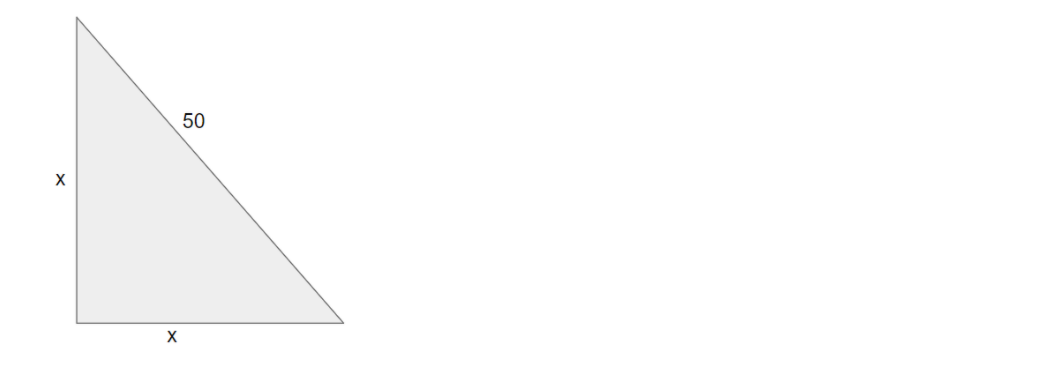
The two legs of a right triangle are equal and the square of its hypotenuse is 50. Find the length of each leg.
Answer
578.1k+ views
Hint: We will first construct the figure of the right-angled triangle. We are given that two sides of the right triangle are equal and the value of hypotenuse is given. So, we will let the sides of the triangle be \[x\] and use the Pythagoras theorem as base and height are equal to the right triangle and put the value of the hypotenuse. From here, we will solve for \[x\] and determine the length of each leg.
Complete step by step answer:
We will first start by considering the given data that two sides are equal to the right triangle and the square of the hypotenuse is given as 50.
We will draw the figure as follows,
So, we will let the two sides of the right triangle that is base and height as \[x\].

Now, we will apply the Pythagoras theorem,
We know that Pythagoras theorem is given by \[{\left( {{\text{Hypotenuse}}} \right)^2} = {\left( {{\text{height}}} \right)^2} + {\left( {{\text{base}}} \right)^2}\].
Thus, we will substitute the values and find the value of each leg.
\[
\Rightarrow \left( {{\text{50}}} \right) = {\left( x \right)^2} + {\left( x \right)^2} \\
\Rightarrow 50 = 2{x^2} \\
\Rightarrow {x^2} = 25 \\
\]
Now, we will find the square root of the obtained value. Thus, we get,
\[ \Rightarrow x = \pm 5\]
As the sides can not be negative so, we will consider the positive value.
Hence, we can conclude that the length of each leg is 5.
Note: We have to use the concept of Pythagoras theorem in this question so, we have to remember the formula for it that is \[{\left( {{\text{Hypotenuse}}} \right)^2} = {\left( {{\text{height}}} \right)^2} + {\left( {{\text{base}}} \right)^2}\]. We have ignored the negative value as negative length or side is not possible. As the other two sides are equal, we have let the side as \[x\]. As in the question we are already given the square of hypotenuse as \[50\] not the value of hypotenuse. Construct the figure of the right-angled triangle.
Complete step by step answer:
We will first start by considering the given data that two sides are equal to the right triangle and the square of the hypotenuse is given as 50.
We will draw the figure as follows,
So, we will let the two sides of the right triangle that is base and height as \[x\].

Now, we will apply the Pythagoras theorem,
We know that Pythagoras theorem is given by \[{\left( {{\text{Hypotenuse}}} \right)^2} = {\left( {{\text{height}}} \right)^2} + {\left( {{\text{base}}} \right)^2}\].
Thus, we will substitute the values and find the value of each leg.
\[
\Rightarrow \left( {{\text{50}}} \right) = {\left( x \right)^2} + {\left( x \right)^2} \\
\Rightarrow 50 = 2{x^2} \\
\Rightarrow {x^2} = 25 \\
\]
Now, we will find the square root of the obtained value. Thus, we get,
\[ \Rightarrow x = \pm 5\]
As the sides can not be negative so, we will consider the positive value.
Hence, we can conclude that the length of each leg is 5.
Note: We have to use the concept of Pythagoras theorem in this question so, we have to remember the formula for it that is \[{\left( {{\text{Hypotenuse}}} \right)^2} = {\left( {{\text{height}}} \right)^2} + {\left( {{\text{base}}} \right)^2}\]. We have ignored the negative value as negative length or side is not possible. As the other two sides are equal, we have let the side as \[x\]. As in the question we are already given the square of hypotenuse as \[50\] not the value of hypotenuse. Construct the figure of the right-angled triangle.
Recently Updated Pages
Master Class 9 Social Science: Engaging Questions & Answers for Success

Master Class 9 Science: Engaging Questions & Answers for Success

Master Class 9 English: Engaging Questions & Answers for Success

Master Class 9 Maths: Engaging Questions & Answers for Success

Master Class 11 Chemistry: Engaging Questions & Answers for Success

Master Class 10 General Knowledge: Engaging Questions & Answers for Success

Trending doubts
Which places in India experience sunrise first and class 9 social science CBSE

Fill the blanks with the suitable prepositions 1 The class 9 english CBSE

Write the 6 fundamental rights of India and explain in detail

Difference Between Plant Cell and Animal Cell

What is the Full Form of ISI and RAW

What is pollution? How many types of pollution? Define it





